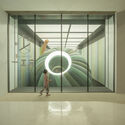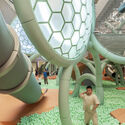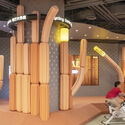
-
Architects: waa
- Area: 1275 m²
- Year: 2023
-
Photographs:Fangfang Tian

Text description provided by the architects. Narrative. A sports centre for the family focuses on Body Movement awareness and development, through play. The BE1ST an “Atlas of Superpower” is a collection of special qualities we can observe in the world around us. waa was commissioned to design a series of family centre’s focusing on sports activity. We believe to collect superpowers of All age family mermbers development, each BE1ST will represent one of these superpowers. The concept focus’s around a fictitious mythical island which situates specific locations these special super organisms embodying superpowers. In this first edition of the series we selected arid land observing plants with ‘superpowers’ to overcome extreme climates. Cacti can survive in extremely arid environments by storing water in their stems, and their robust root systems and needle-like leaves provide protection. We have simulated three representative cactus plants within the venue: saguaro (Carnegiea), Golden Barrel (Echinocactus) and Prickly pears (Opuntia).



























